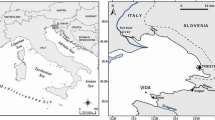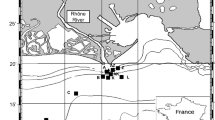Abstract
Chemical changes in anoxic tidal waters, emerging from the mangrove forest of Cananeia, (48° W, 25° S; Brazil), were interpreted using a stoichiometric approach. Significant depletion of magnesium and sulphates were observed and were apparently due to magnesium-iron replacement in octahedral sheets of clay minerals, and sulphate reduction, respectively. Iron release from clays, after bacterial-mediated reduction, apparently reacted with sulphides produced by sulphate reduction to form nono- and di-sulphides. Production of 41.5% of FeS and 58.5% of FeS2satisfactorily explained all the stoichiometric relations between concentration changes of magnesium, sulphates, sulphides, iron and alkalinity expected by the model. As a consequence, the decomposition rate of organic matter in these prevailing anoxic conditions, would mainly stem from sulphate reduction (90% against 10% for ferrireduction). The simultaneous bacterial processes of uptake and release of ammonium included in the model would explain why the mangrove forest does not export significant amounts of nitrogen toward the adjacent lagoon.
Similar content being viewed by others
References
Alongi, M.D., Boto, K.G. and Tirendi, F. 1989. Exported mangrove litter on bacterial productivity and dissolved organic carbon fluxes in adjacent tropical nearshore sediments.Mar. Ecol. Prog. Ser. 56: 133–144
Alongi, M.D., Christoffersen, P. and Tirendi, F. 1993. The influence of forest type on microbial-nutrient relationships in tropical mangrove sediments J. Exp. Mar. Biol. Ecol. 171: 201–223.
Aragon, G.T., Ovalle, A.R.C., Miguens, F.C., Rezende, C.E. and Carmouze, J.-P. 1996. Pyrite formation in mangrove sediments, Brazil. pp. 29–33. In: Bottrell, S.H. (ed.), Proceedings of the Fourth International Symposium on the Geochemistry of the Earth's Surface, Short Papers. University of Leeds, 1996.
Blackburn, T.H. 1979. Nitrogen/carbon ratios ant rates of ammonia turnover in anoxic sediments. pp. 148–153. In: Bourquin, A.W. and Pritchard, D.H. (eds), Proceeeding of the Workshop: Microbial Degradation of Pollutants in Marine Environments. National Technical Information Service, Springfield, VA.
Blackburn, T.H., Christensen, D., Fanger, A.M., Henriksen, K., Iizumi, H., Iversen, N. and Limsaishol, P. 1987. Mineralization processes in mangrove and seagrass sediments. pp. 22–32. In: Hylleberg Institute of Ecology and Genetics (ed.). Ao Yon – a Mangrove in the Adaman Sea. Aarrhus University, Aarhus.
Boon, P.I. and Cain, S. 1988. Nitrogen cycling in salt-marsh and mangrove sediments at Western Port, Victoria. Aust. J. Mar. Freshwater Res. 39: 607–623.
Boto, K.G. and Wellington, J.T. 1988. Seasonnal variations in concentrations and fluxes of dissolved organic and inorganic material in a tropical tidely-dominated mangrove waterway. Mar Ecol. Prog. Ser. 50: 151–160.
Boto, K.G. 1992. Nutrients and mangroves. pp. 130–145. In: Connell, D.W. and Hanker, D.W. (eds), Pollution in Tropical Aquatic Systems. CRC Press, Boca Raton.
Botrell, S.M., Smart, P.L., Whitaker, F. and Raiswel, R. 1991. Geochemistry and isotopie systematics of sulfur in the mixing zone of Bahamian blue holes. Applied Geochemistry 6: 97–103.
Carmouze, J.-P. 1995. O metabolismo dos ecossistemas aquáticos. Edited by Edgar Blusher, São Paulo, 254 pp.
Cauwet, G. 1988. Distribution and accumulation of organic matter in a tropical coastal lagoon, the Tacariga Lagoon, Venezuela. Sci. Total Environ. 75: 261–270.
Cline, J.D. 1969. Spectrophotometric determination of hydrogen sulfide in natural waters. Limnol. Oceanogr. 14: 454–458.
Derek, R.L. and Phillips, E.J.P. 1986. Organic matter mineralization with reduction of ferric iron in anaerobic sediments Applied and Environnental Microbiology 51: 683–689.
Drever, J.I. 1971. Manesium-iron replacement in clay minerals in anoxic marine sediments. Science 172: 1334–1336. Giblin, A.E. and Howarth, R.W. 1984. Porewater evidence for a dynamic sedimentary iron cycle in salt marshes. Limnol. Oceanogr. 29: 47–63.
Gran, G. 1952. Determination of the equivalent point in potentiometric titrations Part II. Analyst 77: 661–671.
Grasshoff, K. 1976. The automatic determination of nitrate. pp. 278–281. In: Grasshoff, K. (ed.), Methods of SeaWater Analisis. Verlag Chemie, Weinheim.
Haines, E.B., 1979. Interactions between Gorgia salt marshes and coastal waters: a changing paradigm. pp. 35–46. In: Livingston, R.J. (ed.) Ecological Processes in Coastal and Marine Systems. Proceeding of the Symposium at Florida State University, April 1978. Plenum Press, New York.
Howarth, R.W. 1979. Pyrite: its rapid formation in a salt marsh and its importance in ecosystem metabolism. Science vol. 203, pp. 49–51.
Iizumi, H. 1986. Soil nutrient dynamics. pp. 171–180. In: Cragg, S. and Polumin, N. (eds), Workshop on Mangrove Ecosystem Dynamics. UNDP UNESCO Regional Project RAS 79002, New Delhi.
Ivanic, I. and Deggobis, D. 1984. An optimal manual procedure for amonia analysis in natural waters by the indophenol blue method. Water Res. 18: 1143–1147.
Kent, D.B. and Kastner, M. 1985. Mg2+ removal in the system Mg2+-amorphous SiO2H2O by adsorption and Mghydroxysilicate precipitation. Geochemica et Cosmochimica Acta vol 49, pp. 1123–1136.
King, G.M., Howes, B.L. and Dacey, J.W.H. 1985. Short term end-product of sulfate reduction in a salt marsh: formation of acide volatile sulfides, elemental sulfur and pyrite. Geochemica et Cosmochimica Acta 49: 1561–1566.
Kristensen, E., Hommer, M. and Bussarawit, N. 1991. Benthic metabolism and sulfate reduction in a south-east Asian mangrove swamp. Mar. Ecol. Prog. Ser. 73: 93–103.
Lovley, R.D. 1987. Organic matter mineralization with the reduction of ferric iron: a review. Geomicrobiology Journal 5: 375–399.
Munch, J.C. and Ottow, J.C.G. 1983. Reductive transformation mechanism of ferric oxydes in hydromorphic soils. Environnemental Biogeochemistry. Halberg R. (Ed. Ecoll. Bull. (Stockholm) 35: 383–394.
Nixon, S.W., Furnas, B.N., Lee, V., Marshall, N., Ong, J.E., Wong, C.H., Gong, W.K. and Sasekumar, A. 1984. The role of mangroves in the carbon and nutrient dynamics of Malesia estuaries. pp. 535–554. In: Soepardmo, E., Rao, A.N. and Macintosh, D.J. (eds), Proceedings Asian Symposium on mangrove environment: research and management. University of Malaya, Kuala Lumpur.
Naidoo, G., 1990. Effects of nitrate, amonium and salinity on growth of the mangrove. Bruguiera gymnorhiza (L.) Lam. Aquatic Bot. 38: 209–219.
Odum, W.E., Fisher, J.S. and Pickral, J.C., 1979. Factors controlling the flux of particulate water organic carbon from estuarine wetlands. pp. 69–80. In: Livingstone, R.J. (ed.), Ecological Processes in Coastal and Marine Systems. Plenum Press, New York.
Overmann, J., Beatty, J.T., Krouse, H.R. and Hall, K.J. 1996. The sulfur cycle in the chemiocline of a meromictic salt lake. Limnol. Oceanogr. 41: 147–156.
Ovalle, A.R.C., Rezende, C.E., Lacerda, L.D. and Silva, C.A.R. 1990. Factors affecting the hydrochemistry of a mangrove tidal creek, Sepetiba Bay, Brazil. Estuarine Coastal Shelf Sci. 31: 639–650.
Qasim, S.Z. and Wafar, V.M. 1990. Marine ressources in the tropics. pp. 141–169. In: Furtade, J.I., Morgan, W.B., Pfaffin, J.R. and Ruddle, K. (eds), Tropical Ressources: Ecology and Developpement. Harwood Academic Publishers. London.
Rickard, D.T. 1975. Kinetics and mechanism of pyrite formation at low temperatures. Am. J. Sci. 275: 636–652.
Shaiful, A.A.A., Abdul Manan, D.M., Ramli, M.R., and Veerasamy, R. 1996. Amonification and nitrification in wet mangrove soils. Malaysia J. Sci. 8: 47–56.
Taylor, P., Rummery, T.E., and Owen, D.G. 1979. Reaction of iron monosulfide solids with aqueous hydrogen sulfide up to 160 °C. J. Inorg. Nucl. Chem. Vol 41: 1683–1687.
Stookey, L.L. 1970. Ferrozine. A new spectrophotometric reagent for iron. Anal. Chem. 41: 143–146.
Valelia, I., Teal, J., Volkmann, S., Shafer, D. and Carpenter, E.J., 1978. Nutrients and particulate fluxes in a salt marsh ecosystem: tidal exchanges and inputs by precipitation and ground water. Limnol. Oceanogr. 23: 798–812.
Author information
Authors and Affiliations
Rights and permissions
About this article
Cite this article
Carmouze, JP., Galvão, S., Nishiara, L. et al. Modelling chemical changes of tidal waters emerging from a mangrove forest at Cananeia, Brazil. Mangroves and Salt Marshes 2, 43–49 (1998). https://doi.org/10.1023/A:1009993823931
Issue Date:
DOI: https://doi.org/10.1023/A:1009993823931




